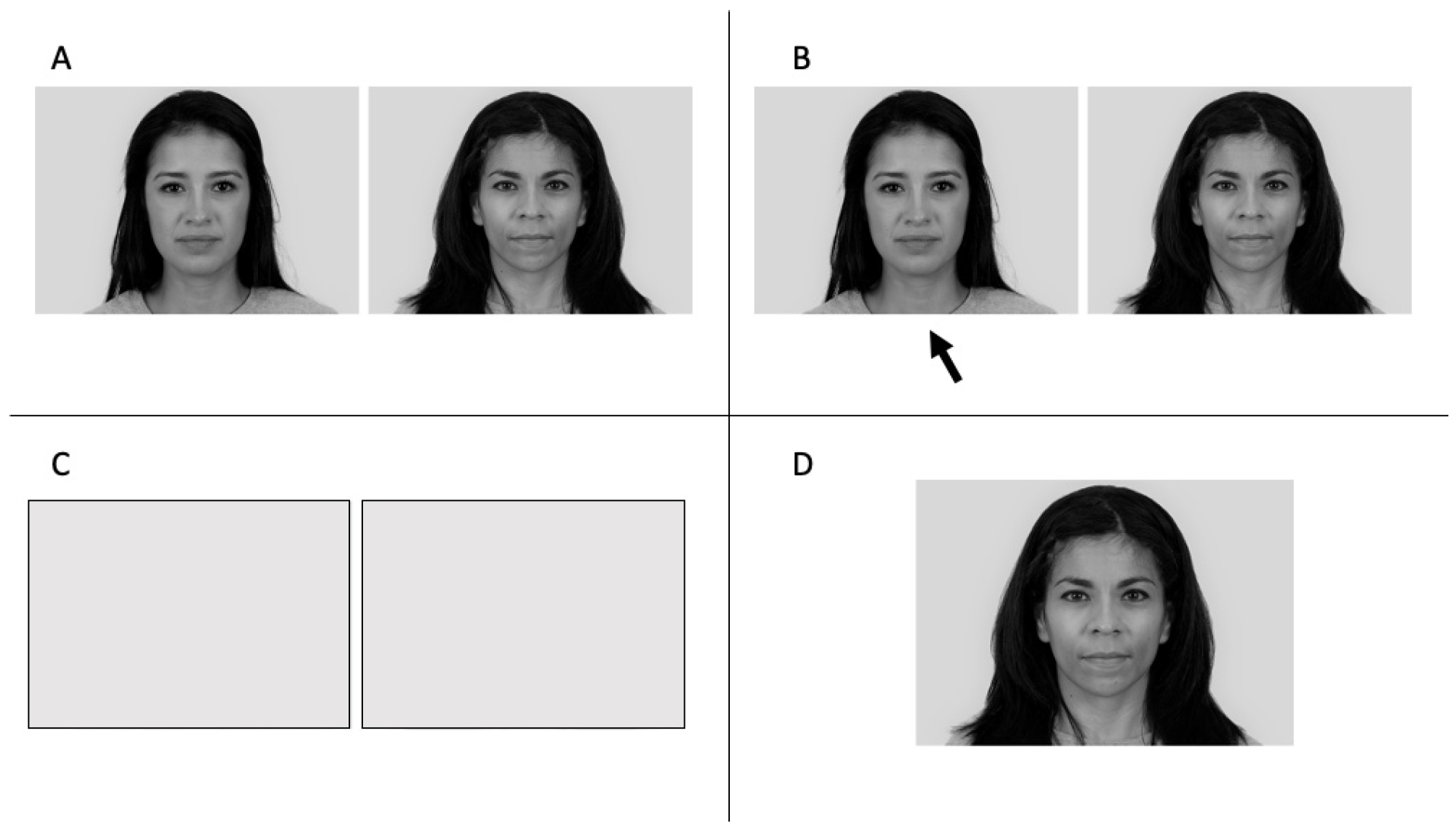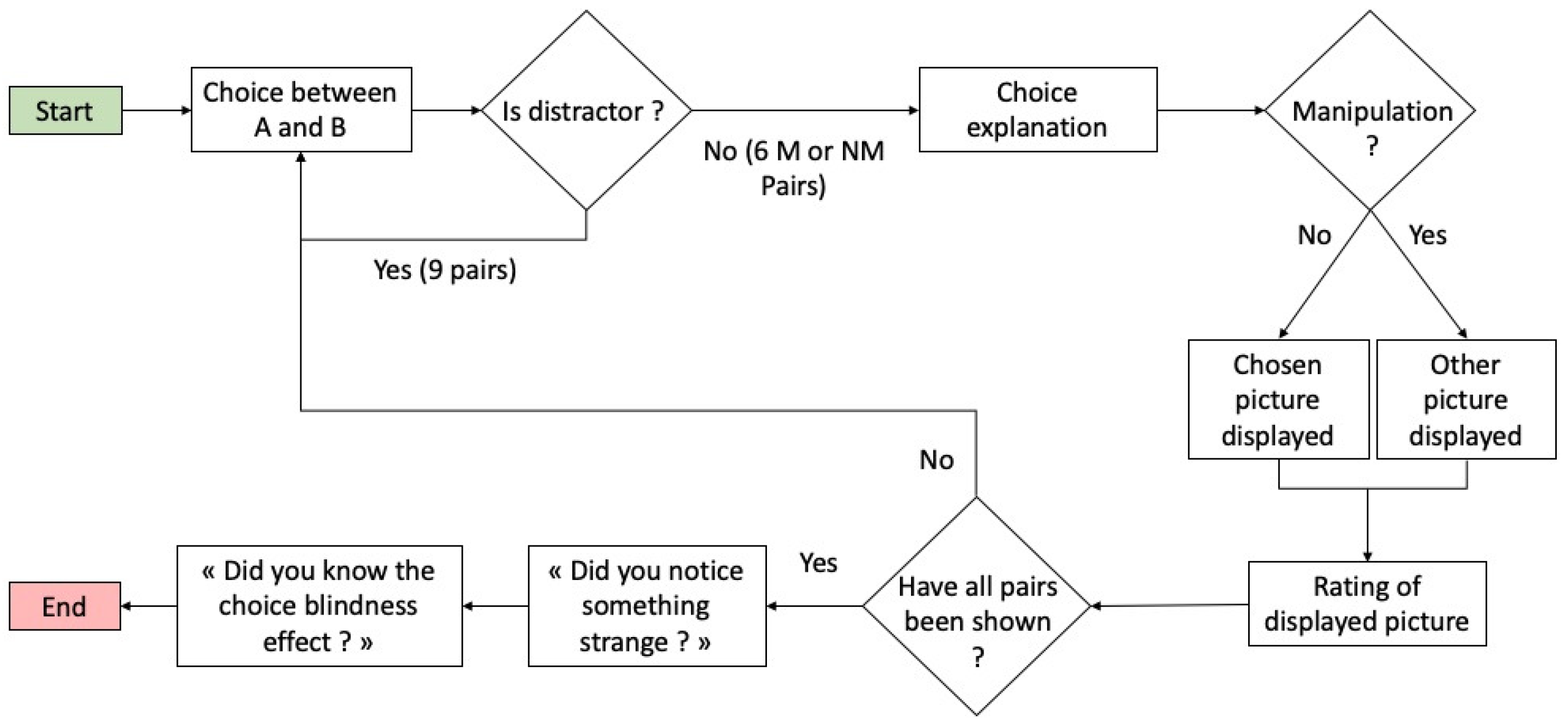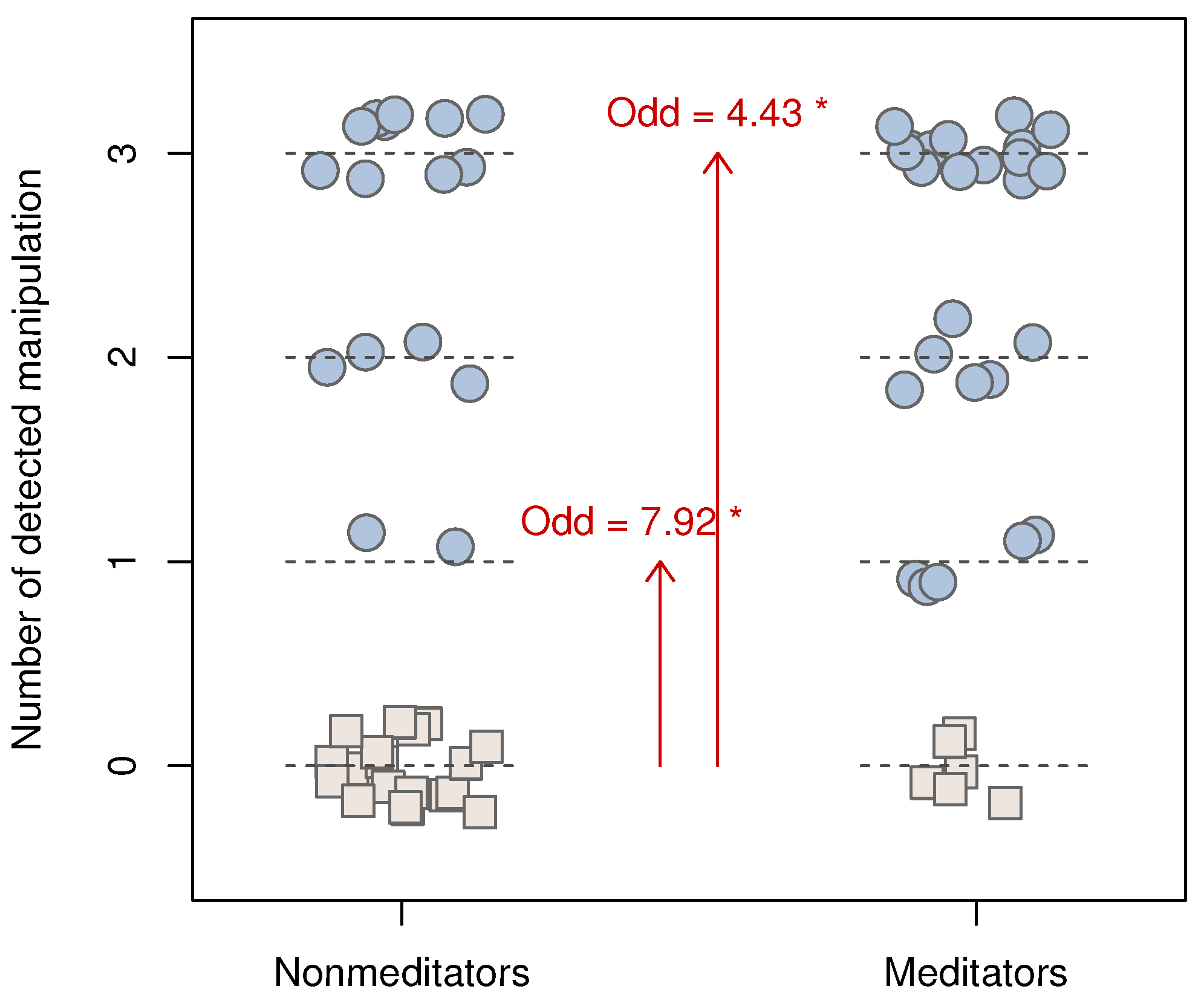Reducing Choice-Blindness? An Experimental Study Comparing Experienced Meditators to Non-Meditators
Abstract
1. Introduction
1.1. The Practice of Mindfulness Meditation and Its Cognitive Effects
1.2. The “Mindful” Personality Trait: A Possible Consequence of Mindfulness Practice
1.3. The Choice-Blindness Paradigm
2. Materials and Methods
2.1. Participants
2.2. Definition of the Groups
2.3. Materials and Procedure
2.4. Statistical Analyses
3. Results
3.1. Socio-Demographic Analyses
3.2. Percentage of Manipulation Detection
3.3. Multinomial Models and Odd Ratio
4. Discussion
4.1. Interpretations
4.2. Limitations
5. Conclusions
Author Contributions
Funding
Institutional Review Board Statement
Informed Consent Statement
Data Availability Statement
Acknowledgments
Conflicts of Interest
Abbreviations
| AIC | Akaike Information Criterion |
| BIC | Bayesian Information Criterion |
| CB | Choice-Blindness |
| FMI | Freiburg Mindfulness Inventory |
| M | Manipulated |
| NM | Non-Manipulated |
References
- Hafenbrack, A.C.; Kinias, Z.; Barsade, S.G. Debiasing the mind through meditation: Mindfulness and the sunk-cost bias. Psychol. Sci. 2014, 25, 369–376. [Google Scholar] [CrossRef]
- Liu, S.; Liu, Y.; Ni, Y. A review of mindfulness improves decision making and future prospects. Psychology 2018, 9, 229–248. [Google Scholar] [CrossRef]
- Raglan, G.; Schulkin, J. Decision making, mindfulness, and mood: How mindfulness techniques can reduce the impact of biases and heuristics through improved decision making and positive affect. J. Depress. Anxiety 2014, 4, 1000168. [Google Scholar] [CrossRef]
- Sun, S.; Yao, Z.; Wei, J.; Yu, R. Calm and smart? A selective review of meditation effects on decision making. Front. Psychol. 2015, 6, 1059. [Google Scholar] [CrossRef]
- Frank, P.; Sundermann, A.; Fischer, D. How mindfulness training cultivates introspection and competence development for sustainable consumption. Int. J. Sustain. High. Educ. 2019, 20, 1002–1021. [Google Scholar] [CrossRef]
- Gibson, J. Mindfulness, interoception, and the body: A contemporary perspective. Front. Psychol. 2019, 10, 2012. [Google Scholar] [CrossRef]
- Fiol, C.M.; O’Connor, E.J. Waking up! Mindfulness in the face of bandwagons. Acad. Manag. Rev. 2003, 28, 54–70. [Google Scholar] [CrossRef]
- Schofield, T.P.; Creswell, J.D.; Denson, T.F. Brief mindfulness induction reduces inattentional blindness. Conscious. Cogn. 2015, 37, 63–70. [Google Scholar] [CrossRef]
- Johansson, P.; Hall, L.; Sikström, S.; Olsson, A. Failure to detect mismatches between intention and outcome in a simple decision task. Science 2005, 310, 116–119. [Google Scholar] [CrossRef]
- Bortolotti, L.; Sullivan-Bissett, E. Is choice blindness a case of self-ignorance? Synthese 2021, 198, 5437–5454. [Google Scholar] [CrossRef]
- Chen, M.K.; Risen, J.L. How choice affects and reflects preferences: Revisiting the free-choice paradigm. J. Personal. Soc. Psychol. 2010, 99, 573. [Google Scholar] [CrossRef]
- Hall, L.; Strandberg, T.; Pärnamets, P.; Lind, A.; Tärning, B.; Johansson, P. How the polls can be both spot on and dead wrong: Using choice blindness to shift political attitudes and voter intentions. PLoS ONE 2013, 8, e60554. [Google Scholar] [CrossRef]
- Ariely, D.; Norton, M.I. How actions create–not just reveal–preferences. Trends Cogn. Sci. 2008, 12, 13–16. [Google Scholar] [CrossRef]
- Cheung, T.; Junghans, A.; Dijksterhuis, G.; Kroese, F.; Johansson, P.; Hall, L.; De Ridder, D. Consumers’ choice-blindness to ingredient information. Appetite 2016, 106, 2–12. [Google Scholar] [CrossRef]
- Hall, L.; Johansson, P.; Tärning, B.; Sikström, S.; Deutgen, T. Magic at the marketplace: Choice blindness for the taste of jam and the smell of tea. Cognition 2010, 117, 54–61. [Google Scholar] [CrossRef]
- Hall, L.; Johansson, P. Using choice blindness to study decision making and introspection. In Cognition–A Smorgasbord; Gärdenfors, P., Wallin, A., Eds.; Bokförlaget Nya Doxa: Nora, Sweden, 2008; pp. 267–283. [Google Scholar]
- Pärnamets, P.; Hall, L.; Johansson, P. Memory distortions resulting from a choice blindness task. In Proceedings of the 37th Annual Conference of the Cognitive Science Society: Mind, Technology, and Society, Pasadena, CA, USA, 22–25 July 2015; Cognitive Science Society, Inc.: Seattle, WA, USA, 2015; pp. 1823–1828. [Google Scholar]
- Petitmengin, C.; Remillieux, A.; Cahour, B.; Carter-Thomas, S. A gap in Nisbett and Wilson’s findings? A first-person access to our cognitive processes. Conscious. Cogn. 2013, 22, 654–669. [Google Scholar] [CrossRef]
- Vermersch, P. L’entretien d’explicitation; ESF Sciences Humaines: Paris, France, 1994. [Google Scholar]
- Vermersch, P. Introspection as practice. J. Conscious. Stud. 1999, 6, 17–42. [Google Scholar]
- Brown, K.W.; Ryan, R.M. The benefits of being present: Mindfulness and its role in psychological well-being. J. Personal. Soc. Psychol. 2003, 84, 822. [Google Scholar] [CrossRef]
- Kabat-Zinn, J.; Lipworth, L.; Burney, R. The clinical use of mindfulness meditation for the self-regulation of chronic pain. J. Behav. Med. 1985, 8, 163–190. [Google Scholar] [CrossRef]
- Kang, Y.; Gruber, J.; Gray, J.R. Mindfulness and de-automatization. Emot. Rev. 2013, 5, 192–201. [Google Scholar] [CrossRef]
- Bishop, S.R.; Lau, M.; Shapiro, S.; Carlson, L.; Anderson, N.D.; Carmody, J.; Segal, Z.V.; Abbey, S.; Speca, M.; Velting, D.; et al. Mindfulness: A proposed operational definition. Clin. Psychol. Sci. Pract. 2004, 11, 230. [Google Scholar] [CrossRef]
- Tang, Y.Y.; Hölzel, B.K.; Posner, M.I. The neuroscience of mindfulness meditation. Nat. Rev. Neurosci. 2015, 16, 213–225. [Google Scholar] [CrossRef] [PubMed]
- Vago, D.R.; David, S.A. Self-awareness, self-regulation, and self-transcendence (S-ART): A framework for understanding the neurobiological mechanisms of mindfulness. Front. Hum. Neurosci. 2012, 6, 296. [Google Scholar] [CrossRef]
- Malinowski, P. Neural mechanisms of attentional control in mindfulness meditation. Front. Neurosci. 2013, 7, 8. [Google Scholar] [CrossRef]
- Baer, R.A.; Smith, G.T.; Hopkins, J.; Krietemeyer, J.; Toney, L. Using self-report assessment methods to explore facets of mindfulness. Assessment 2006, 13, 27–45. [Google Scholar] [CrossRef]
- Kabat-Zinn, J. Mindfulness-Based Interventions in Context: Past, Present, and Future; Blackwell Publishing: Hoboken, NJ, USA, 2003. [Google Scholar] [CrossRef]
- Kiken, L.G.; Garland, E.L.; Bluth, K.; Palsson, O.S.; Gaylord, S.A. From a state to a trait: Trajectories of state mindfulness in meditation during intervention predict changes in trait mindfulness. Personal. Individ. Differ. 2015, 81, 41–46. [Google Scholar] [CrossRef]
- Brown, D.; Forte, M.; Dysart, M. Differences in visual sensitivity among mindfulness meditators and non-meditators. Percept. Mot. Ski. 1984, 58, 727–733. [Google Scholar] [CrossRef]
- Brandtner, A.; Antons, S.; King, D.L.; Potenza, M.N.; Tang, Y.Y.; Blycker, G.R.; Brand, M.; Liebherr, M. A preregistered, systematic review considering mindfulness-based interventions and neurofeedback for targeting affective and cognitive processes in behavioral addictions. Clin. Psychol. Sci. Pract. 2022; in press. [Google Scholar] [CrossRef]
- Mrazek, M.D.; Franklin, M.S.; Phillips, D.T.; Baird, B.; Schooler, J.W. Mindfulness training improves working memory capacity and GRE performance while reducing mind wandering. Psychol. Sci. 2013, 24, 776–781. [Google Scholar] [CrossRef]
- Black, D.S.; Sussman, S.; Johnson, C.A.; Milam, J. Trait mindfulness helps shield decision-making from translating into health-risk behavior. J. Adolesc. Health 2012, 51, 588–592. [Google Scholar] [CrossRef]
- Kirk, U.; Gu, X.; Sharp, C.; Hula, A.; Fonagy, P.; Montague, P.R. Mindfulness training increases cooperative decision making in economic exchanges: Evidence from fMRI. NeuroImage 2016, 138, 274–283. [Google Scholar] [CrossRef]
- Shapiro, S.L.; Jazaieri, H.; Goldin, P.R. Mindfulness-based stress reduction effects on moral reasoning and decision making. J. Posit. Psychol. 2012, 7, 504–515. [Google Scholar] [CrossRef]
- Carlson, E.N. Overcoming the barriers to self-knowledge: Mindfulness as a path to seeing yourself as you really are. Perspect. Psychol. Sci. 2013, 8, 173–186. [Google Scholar] [CrossRef]
- Walach, H.; Buchheld, N.; Buttenmüller, V.; Kleinknecht, N.; Schmidt, S. Measuring mindfulness—the Freiburg mindfulness inventory (FMI). Personal. Individ. Differ. 2006, 40, 1543–1555. [Google Scholar] [CrossRef]
- Trousselard, M.; Steiler, D.; Raphel, C.; Cian, C.; Duymedjian, R.; Claverie, D.; Canini, F. Validation of a French version of the Freiburg Mindfulness Inventory-short version: Relationships between mindfulness and stress in an adult population. BioPsychoSocial Med. 2010, 4, 8. [Google Scholar] [CrossRef]
- Buchheld, N.; Grossman, P.; Walach, H. Measuring mindfulness in insight meditation (Vipassana) and meditation-based psychotherapy: The development of the Freiburg Mindfulness Inventory (FMI). J. Medit. Medit. Res. 2001, 1, 11–34. [Google Scholar]
- Lehto, J.E.; Uusitalo-Malmivaara, L.; Repo, S. Measuring mindfulness and well-being in adults: The role of age and meditation experience. J. Happiness Well-Being 2015, 3, 30–40. [Google Scholar]
- Hall, L.; Johansson, P.; Strandberg, T. Lifting the veil of morality: Choice blindness and attitude reversals on a self-transforming survey. PLoS ONE 2012, 7, e45457. [Google Scholar] [CrossRef]
- Johansson, P.; Hall, L.; Tärning, B.; Sikström, S.; Chater, N. Choice blindness and preference change: You will like this paper better if you (believe you) chose to read it! J. Behav. Decis. Mak. 2014, 27, 281–289. [Google Scholar] [CrossRef]
- Johansson, P.; Hall, L.; Sikström, S.; Tärning, B.; Lind, A. How something can be said about telling more than we can know: On choice blindness and introspection. Conscious. Cogn. 2006, 15, 673–692. [Google Scholar] [CrossRef]
- Steenfeldt-Kristensen, C.; Thornton, I.M. Haptic choice blindness. i-Perception 2013, 4, 207–210. [Google Scholar] [CrossRef]
- Lind, A.; Hall, L.; Breidegard, B.; Balkenius, C.; Johansson, P. Speakers’ acceptance of real-time speech exchange indicates that we use auditory feedback to specify the meaning of what we say. Psychol. Sci. 2014, 25, 1198–1205. [Google Scholar] [CrossRef]
- Huangfu, H.; Lu, Y.; Fu, S. A Visual Cognition Test-Based Study on the Choice Blindness Persistence: Impacts of Positive Emotion and Picture Similarity. In Engineering Psychology and Cognitive Ergonomics. HCII 2019; Harris, D., Ed.; Lecture Notes in Computer Science; Springer: Cham, Switzerland, 2019; Volume 11571. [Google Scholar] [CrossRef]
- Birtwell, K.; Williams, K.; Van Marwijk, H.; Armitage, C.J.; Sheffield, D. An exploration of formal and informal mindfulness practice and associations with wellbeing. Mindfulness 2019, 10, 89–99. [Google Scholar] [CrossRef] [PubMed]
- Davidson, R.; Schuyler, B. Neuroscience du bonheur. Revue québécoise de Psychologie 2017, 38, 39–64. [Google Scholar] [CrossRef][Green Version]
- Johansson, P.; Hall, L.; Gulz, A.; Haake, M.; Watanabe, K. Choice Blindness and Trust in the Virtual World; Technical Report of IEICE: HIP; Lund University: Lund, Sweden, 2007; Volume 107, pp. 83–86. [Google Scholar]
- Johansson, P.; Hall, L.; Sikström, S. From change blindness to choice blindness. Psychologia 2008, 51, 142–155. [Google Scholar] [CrossRef]
- Arora, J.; Gupta, M.; Parnami, A. Choose a lift and walk into it: Manifesting Choice Blindness in Real-life Scenarios using Immersive Virtual Reality. In Proceedings of the Adjunct Publication of the 32nd Annual ACM Symposium on User Interface Software and Technology, New Orleans, LA, USA, 20–23 October 2019; pp. 84–86. [Google Scholar]
- Daubenmier, J.; Sze, J.; Kerr, C.E.; Kemeny, M.E.; Mehling, W. Follow your breath: Respiratory interoceptive accuracy in experienced meditators. Psychophysiology 2013, 50, 777–789. [Google Scholar] [CrossRef] [PubMed]
- Khalsa, S.S.; Rudrauf, D.; Damasio, A.R.; Davidson, R.J.; Lutz, A.; Tranel, D. Interoceptive awareness in experienced meditators. Psychophysiology 2008, 45, 671–677. [Google Scholar] [CrossRef]
- Kumari, V.; Antonova, E.; Wright, B.; Hamid, A.; Hernandez, E.M.; Schmechtig, A.; Ettinger, U. The mindful eye: Smooth pursuit and saccadic eye movements in meditators and non-meditators. Conscious. Cogn. 2017, 48, 66–75. [Google Scholar] [CrossRef] [PubMed]
- Bainbridge, W.A.; Isola, P.; Oliva, A. The intrinsic memorability of face photographs. J. Exp. Psychol. Gen. 2013, 142, 1323. [Google Scholar] [CrossRef]
- Morris, A. Invisible Gorillas in the Mind: Internal Inattentional Blindness and the Prospect of Introspection Training. PsyArXiv. 2021. Available online: https://europepmc.org/article/PPR/PPR400244 (accessed on 30 October 2022). [CrossRef]
- Shankland, R.; Favre, P.; Kotsou, I.; Mermillod, M. Mindfulness and De-automatization: Effect of Mindfulness-Based Interventions on Emotional Facial Expressions Processing. Mindfulness 2021, 12, 226–239. [Google Scholar] [CrossRef]
- Kahneman, D. Thinking, Fast and Slow; Macmillan: New York, NY, USA, 2011. [Google Scholar]
- Kruger, J.; Dunning, D. Unskilled and unaware of it: How difficulties in recognizing one’s own incompetence lead to inflated self-assessments. J. Personal. Soc. Psychol. 1999, 77, 1121. [Google Scholar] [CrossRef]
- Dunning, D. The Dunning–Kruger effect: On being ignorant of one’s own ignorance. In Advances in Experimental Social Psychology; Elsevier: Austin, TX, USA, 2011; Volume 44, pp. 247–296. [Google Scholar] [CrossRef]
- Belzer, F.; Schmidt, S.; Lucius-Hoene, G.; Schneider, J.F.; Orellana-Rios, C.L.; Sauer, S. Challenging the construct validity of mindfulness assessment—a cognitive interview study of the Freiburg mindfulness inventory. Mindfulness 2013, 4, 33–44. [Google Scholar] [CrossRef]
- Kuha, J. AIC and BIC: Comparisons of assumptions and performance. Sociol. Methods Res. 2004, 33, 188–229. [Google Scholar] [CrossRef]



| Variables | Non-Meditators | Meditators |
|---|---|---|
| Male | 7 | 7 |
| Female | 28 | 23 |
| Other | 0 | 1 |
| 25–35 years | 20 | 13 |
| 36–45 years | 8 | 9 |
| 46–55 years | 7 | 9 |
| BAC | 5 | 1 |
| BTS-DUT | 2 | 2 |
| DUG | 0 | 2 |
| LICENCE | 13 | 9 |
| MAITRISE | 4 | 6 |
| MASTER | 9 | 9 |
| DOCTORAT | 2 | 2 |
| Craftsmen, shopkeepers, company managers | 0 | 1 |
| Executives and higher intellectual professions | 4 | 5 |
| Employee | 1 | 2 |
| Student | 12 | 4 |
| Worker | 1 | 1 |
| Intermediate occupations | 14 | 15 |
| Retired | 1 | 1 |
| Unemployed | 1 | 1 |
| Missing | 1 | 1 |
| FMI score (Mean) | 35.6 | 38.7 |
| Model Name | Log-Likelihood | Degrees of Freedom | Residual Deviance | AIC | BIC |
|---|---|---|---|---|---|
| M1 | −78.4 | 192 | 156.9 | 168.9 | 182.1 |
| M0 | −83.1 | 195 | 166.2 | 172.2 | 178.8 |
| Comparison | Parameter (Odds Ratio) | Std Error | z-Value | p-Value |
|---|---|---|---|---|
| 0–1 | 2.07 (7.92) | 0.96 | 2.16 | 0.031 * |
| 0–2 | 1.56 (4.75) | 0.80 | 1.95 | 0.051 |
| 0–3 | 1.49 (4.43) | 0.63 | 2.38 | 0.017 * |
Publisher’s Note: MDPI stays neutral with regard to jurisdictional claims in published maps and institutional affiliations. |
© 2022 by the authors. Licensee MDPI, Basel, Switzerland. This article is an open access article distributed under the terms and conditions of the Creative Commons Attribution (CC BY) license (https://creativecommons.org/licenses/by/4.0/).
Share and Cite
Lachaud, L.; Jacquet, B.; Baratgin, J. Reducing Choice-Blindness? An Experimental Study Comparing Experienced Meditators to Non-Meditators. Eur. J. Investig. Health Psychol. Educ. 2022, 12, 1607-1620. https://doi.org/10.3390/ejihpe12110113
Lachaud L, Jacquet B, Baratgin J. Reducing Choice-Blindness? An Experimental Study Comparing Experienced Meditators to Non-Meditators. European Journal of Investigation in Health, Psychology and Education. 2022; 12(11):1607-1620. https://doi.org/10.3390/ejihpe12110113
Chicago/Turabian StyleLachaud, Léa, Baptiste Jacquet, and Jean Baratgin. 2022. "Reducing Choice-Blindness? An Experimental Study Comparing Experienced Meditators to Non-Meditators" European Journal of Investigation in Health, Psychology and Education 12, no. 11: 1607-1620. https://doi.org/10.3390/ejihpe12110113
APA StyleLachaud, L., Jacquet, B., & Baratgin, J. (2022). Reducing Choice-Blindness? An Experimental Study Comparing Experienced Meditators to Non-Meditators. European Journal of Investigation in Health, Psychology and Education, 12(11), 1607-1620. https://doi.org/10.3390/ejihpe12110113









